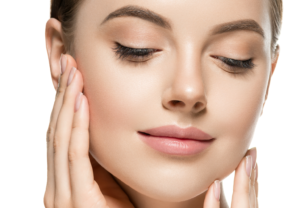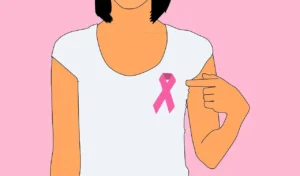The well-known Kim Kardashian has been diagnosed with psoriasis. On different occasions on her social networks, the 39-year-old executive of the cosmetics brand KKW Beauty has published part of her experience with this disease. “If you have psoriasis, you can’t let it ruin your life or get the best of you,” she explained in one of the last photographs she shared about an outbreak that appeared on her face.
She has shown her legs and has also shared other details of what she has experienced with it. This disease affects only 2 or 3% of the population, it is not contagious.
Psoriasis is a chronic skin disease characterized by uncontrolled inflammation and excessive reproduction of keratinocytes (a type of skin cell).
To understand it more simply, dermatologist Maureen Barahona explains that the skin renews itself for the majority of the population in an average of 21 to 28 days, while this cellular renewal in a person with psoriasis due to genetic issues is overstimulated and generates substances that make the skin regenerate faster and takes five to eight days, in this way the new cells accumulate on the surface of the skin and reproduce so quickly that the body can no longer eliminate it.
It manifests itself with physical signs such as redness and scaly, dry, thickened, and inflamed skin lesions, with the extent of affected skin varying from one individual to another. It may cause severe itching and make the person feel uncomfortable all day long.
How to identify it?
Psoriasis patches can range from a few spots of dandruff-like scales to rashes that are spread over larger areas of the skin.
These are some of its symptoms:
Benjamín Hidalgo, an assistant dermatologist in the dermatology service at the National Children’s Hospital of Costa Rica, says that this disease can appear at any age, even in the first months of life, although it is more common between 15 and 35 years of age. It affects men and women equally.
It is an inherited disease. If one of the parents has it, the children have a 15% chance of developing it, while if the child has a twin, the chances increase to more than 70%.
Some factors can worsen or trigger it, such as stress. It has sometimes been associated with its appearance after an infection such as streptococcal tonsillitis. Factors such as smoking or alcohol consumption also have an influence.
Barahona explains that above the age of 40, it is more common for diseases such as diabetes, hypertension, hypothyroidism,m and others to appear, which are factors that also predispose the patient to develop psoriasis. “Inflammation is not limited to the skin and can manifest in other organs and sites, especially cardiac, cerebrovascular, or gastrointestinal. It is a generalized disease although its main manifestation is in the skin,” he adds.
It could affect the hair and be initially confused with dandruff, or appear on the nails or in different parts of the body.
Hidalgo has been in contact with patients with psoriasis for nearly two decades and also recognizes that over the years treatments have evolved and a better quality of life has been achieved for patients.

Of course, it is not just about the pharmacological issues recommended by the dermatologist; having the support of other specialties such as a psychologist and nutritionist could make the difference in achieving a comprehensive treatment.
Being informed, trained, and supported by specialists and other patients is essential for patients who live with psoriasis throughout their lives.
To diagnose it, a physical examination and clinical history are usually sufficient, although sometimes a skin sample, i.e. a biopsy, may be required.
Psoriatic arthritis
Psoriasis may also affect other parts of the body, such as the joints. This arthritis affects between 10 and 30% of patients.
Particularly affected are the joints of the fingers and toes, the lumbar and sacral spine, the wrists, and the knees. In some cases, if left untreated, it can cause irreversible damage to the joints.
It is characterized by inflammation accompanied by pain and increased temperature in the affected area, as well as difficulty moving. A peculiarity is that sometimes this symptom appears months or years after the skin problem, or sometimes the skin lesions are minimal and it is the arthritis that stands out.

It is therefore important to consult a rheumatologist if you experience joint pain or swelling to avoid complications. To relieve pain, you will need to follow treatment with anti-inflammatory drugs, as well as give priority to rehabilitation and exercise, as well as therapies such as applying cold to joints.
Another important point is occupational therapy and learning to make lifestyle changes such as avoiding strain and overload, learning to move, and other actions to take care of the joints.
In search of relief
Psoriasis treatment is focused on the severity of the disease; topical treatment is prescribed in mild cases and systemic treatment in moderate or severe cases.
The disease can have periods of relapses and remissions and despite therapeutic advances, a definitive cure has not yet been possible.
There are a variety of treatments available and it is recommended that you inform yourself about them and reach an agreement with your doctor on which one may be the best to follow. This will include learning about the disease and skin care and making decisions that improve your condition. The goal is for the patient to take an active role in their disease.
The treatment is holistic because it is not just a dermatological component. If there are problems in the joints or other areas, the accompaniment of other specialists may be necessary.
As for the skin, it depends on the severity of the plaque and the percentage of body involvement. Corticosteroids, vitamin D analogs, zinc replacement, anti-inflammatories, and biological options may be required, to name a few, says Barahona.
Hidalgo explains that traditional pharmacological treatments of immunosuppressants that reduce inflammation have been used for years, and like any treatment, they could have adverse effects such as a decrease in red blood cells and/or affect the liver and kidneys, among other issues, which is why it is essential to monitor their use, time and quantities.
Barahona explains that sometimes they are treated with corticosteroids and although these are positive, the quantities or the long-term use of them cause other complications. Prolonged or excessive use can cause thinning of the skin and eventually stop being effective.
It is also important to eat a healthy diet and exercise. The sun is beneficial for most patients because of its vitamin D content, which is recognized to be low in a large number of them. “It is best for them to sunbathe between 7 and 8 in the morning and to eat foods rich in this vitamin, such as dairy products,” explains Barahona.

Protein from meat or vegetables will also help skin health, as well as maintaining adequate levels of hydration. Hidalgo adds that the Mediterranean diet has been considered beneficial, and includes nuts, chickpeas, lentils, vegetables, and fish.
It is necessary to use non-detergent soaps and take care not to injure yourself. It is not advisable to use sponges or scouring pads and to take a short shower with warm, not hot, water.
Hidalgo emphasizes that the goal is to control the disease as much as possible and that if there are lesions, they should be on a minimum of areas of the body.
Beyond the physical
The disease has a significant emotional component. Patients often suffer discrimination and are excluded.
“There is a lot of stigma surrounding the disease, sometimes the patient manages to hide some parts of their body, but when the lesions are visible the patient suffers and is subject to rejection,” says Barahona. Inflammation is even related to psychological and psychiatric morbidities because the disease itself can change receptors at the brain level and they are more prone to depression, suicide, and other psychological illnesses.
Psychological support is also an integral part of this disease, especially when the patient begins to isolate themselves, avoid social activities, and experience depressive episodes. When psoriasis is not controlled, these repercussions can diminish the ability to live life to its fullest potential.
Once treated appropriately, the patient can lead a dignified and quality life, experts conclude.























+ There are no comments
Add yours